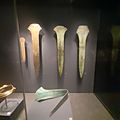Oxborough Dirk facts for kids
Quick facts for kids Oxborough Dirk |
|
|---|---|

The Oxborough Dirk at the British Museum
|
|
| Material | Bronze |
| Size | 70.9 cm (27.9 in) long |
| Weight | 2.36 kilograms (5.2 lb) |
| Created | 1450–1300 BC |
| Discovered | 1988 Near Oxborough, Norfolk |
| Present location | British Museum, London |
| Registration | 1994,1003.1 |
The Oxborough Dirk is a huge, special dagger from the Middle Bronze Age. It's a very rare find, being one of only six such items found across Europe. This amazing object was discovered in the 1980s in a countryside area of Norfolk, England. Today, you can see it in the British Museum in London, as part of their collection of prehistoric items.
Contents
How the Oxborough Dirk Was Found
This unique dagger was found by chance in 1988. It was sticking out of a peat bog near a village called Oxborough in Norfolk. The dagger had been placed point-down in the ground. A person walking in the woods nearby actually tripped over the base of the dagger, which led to its discovery! Six years after it was found, the British Museum bought the dagger. They had help from the National Art Collections Fund.
A Super Rare Discovery
The Oxborough Dirk is one of only six very large daggers like it found in north-west Europe. These daggers are so similar that they might have been made in the same workshop. This means the Oxborough Dirk could have been brought to Britain from another country in Europe.
These six almost identical daggers have been found in three different countries:
- Two in France
- Two in the Netherlands
- Two in England
All six of these very rare daggers are known as the Plougrescant–Ommerschans type. This name comes from two of the places where they were first discovered. Other daggers of this type were found in Beaune and Jutphaas. The British Museum also has the dagger found in Beaune. The second dagger found in Norfolk is at the Norwich Castle Museum. It was discovered in a place called East Rudham.
What the Oxborough Dirk Looks Like
The Oxborough Dirk was made a very long time ago, between 1450 and 1300 BC. It is about 70.9 centimetres (27.9 in) long and weighs 2.37 kilograms (5.2 lb). This makes it "ridiculously large and unwieldy," meaning it's too big and heavy to be used as a regular weapon. There are also no holes on its handle part for attaching a proper grip. This shows it was never meant for fighting.
Instead, it was probably a special votive offering. This means it was given as a gift to gods or spirits. It might also have been a store of value, like a treasure hidden away to be found later. You can see the Oxborough Dirk on display in Room 50 at the British Museum today.
Gallery
-
The Plougrescant sword in the Musee des Antiquites Nationales, Saint-Germain-en-Laye, France
-
Dirk from Jutphaas in the National Museum of Antiquities in Leiden
-
Dirk from Ommerschans in the National Museum of Antiquities in Leiden
-
Dirks from Kimberley, Oxborough, Plougrescant, Beaune and East Rudham respectively in The World of Stonehenge exhibition, British Museum (2022)
See also
- Bronze Age Britain
- Hilversum culture
- Atlantic Bronze Age







